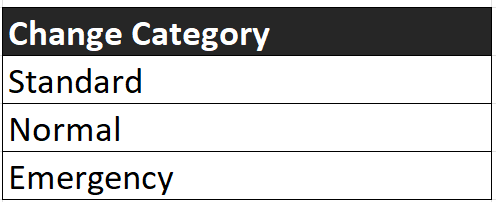What is ITIL change management?
'A monkey in a wrench, fly in the ointment, pain in the ass'.
What exactly is ITIL change management?
'A monkey in the wrench, a fly in the ointment, a pain in the ass' is A statement from the 1980s film "Die Hard," referred to by actor Bruce Willis's character John McClane when speaking on a communications receiver to the villainous hostage-taker Hans Gruber, upsetting his intentions to take control of the Nakatomi Plaza skyscraper.
If you work for an IT business that has used the ITIL framework, you may have battled to have a change approved or even executed because Change Management has decided to red-tape any possibility of the change proceeding. It could be something as minor as another line from the implementation plan being missing from the change record, or it could be that you have tested the situation numerous times but have yet to properly document any proof. This can be aggravating and resentful, especially if your role is to implement changes.
Let's start with ITIL and what it's all about
ITIL is an abbreviation meaning (Information Technology Infrastructure Library). A framework for IT Service Management that provides a set of best practices. In the 1980s, the British Government's Central Computer and Telecommunications Agency, generally known as (CCTA), introduced ITIL. A set of documented best practices was developed expressly for IT Service Management, which has been updated to meet current standards.
Please refer to the link below for a more detailed breakdown.

Firstly, how does ITIL define a change?
A change is defined as an addition, modification or removal of any authorized, planned, supported service or service component that could affect IT services.
What is the purpose of change management?
Change Management is an ITIL-defined function that acts as a gatekeeper to guarantee that there is little risk of harm to service operations and business infrastructure. CM also provides best practices for service development, deployment, and transition. The organisation can make individuals aware of the key features of following the change process while avoiding risk as much as possible by documenting various processes and the change policy.
How Does Change Management work?
Very well, if implemented properly
Anyone can make a change, whether they are carrying it out alone or delegating it to another person or team. There are no restrictions on who can and cannot propose a change. They are the change requester, but they do not have the authority to make the change.
There are some questions we need to ask before we commit to the change.
Justification
What is the reason for the change in the first place?
- To fix a disruption to a service?
- To provide some additional work to improve service.
- A customer request
- 3rd party advisement of a change
- Could there be a financial cost involved if we do or don't implement the change?
Implementation plan
How are we going to carry out the change? What's involved and what's the plan?
- Include any links or details of the plan, preferably in steps.
- Consider available resources and who will need to carry out the change if the requester is not.
Could the change cause any risks?
Perhaps the most vital question to consider.
- Could there be a disruption to service?
- If there is an impact how long do we suspect the service will be down
- Is the customer aware?
- Have we considered the scheduled time and date don't impact the business or client as peak periods?
- Could this change conflict with any other changes happening at the same time, if any?
Can the change be rolled back?
- Are there steps we can take to roll the change back?
- How long will the change take to roll back if an issue should occur?
- If we can't roll the change back, can we easily fixed forward?
Have we carried out the change in a test environment?
- Do we have evidence of successful implementation in a test environment?
- Do we still need to test?
- If we are unable to test, do we have scenarios of what could impact once the change is carried out in a live production environment?
The Seven R's of Change Management
Another way to keep in mind, the change requirements is to remember and learn the seven R's of Change Management. Especially if you are someone who doesn't request changes very often. Referring to the seven R's can make it easier if you need to create a change quickly and which also might need authorisation.
- Who raised the change? ...
- What is the reason for the change? ...
- What return is required from the change? ...
- What are the risks involved in the change? ...
- What resources are required to deliver the change? ...
- Who is responsible for the “build, test, and implement” of the change?
- What is the relationship with other changes?
Categorizing Changes
Categorization of changes is a key part of the change process as some changes will take priority over others.
Let's take a look at the various categories in the table below.

Standard Change
A standard change is a non-impacting pre-authorised change, considered low risk. Standard changes are frequent and documented which most individuals can easily understand. A standard change can only be recognised as standard once it's been signed off by the Change Advisory Board.
Normal Change
Normal changes are not standard or emergency and must follow the change management process. Normal changes may be first-time changes that have never been done before, so could pose an element of risk. Others will have a known risk but still needs to be implemented.
All normal changes will need to be approved by the Change Advisory Board (CAB).
Emergency Change
Emergency changes need to be implemented urgently as it normally means a priority service has been impacted or the business infrastructure may require an urgent patch to prevent an outage. There could be many reasons.
Emergency changes have a higher risk of failure. They will need to be signed off by the Emergency Change Advisory board ECAB).
Too many emergency changes aren't a good thing and can lead to more problems further down the line.
- Unplanned changes lead to more risks
- The right resources might not be available
- No time to test
- inconvenience to clients who might not want a change implemented during their peak period
- Other functions in the business might not be aware of the emergency and have no visibility of impact should the change fail.
- Seeking approval from the senior management team may not always be easy depending on their availability, although the pool of eligible approvers should be flexible.
A Retrospective Change
Some emergency changes will need to happen out of core hours which might not always get the approvals as the change has to happen immediately. If this is the case then an emergency change will still need to be submitted retrospectively to ensure its documented and Change Management are aware of when it was scheduled.
Who are the Change Advisory Board (CAB) and what do they do?
The Change Advisory (CAB) is made up of individuals who have the authority to approve or reject a change.
As an example, these individuals could be a technical lead, financial officer, operations manager or even a CEO depending on the change that has been brought to the CAB meeting to be assessed. Normally senior management of the business will be the main approvers.
The meeting is normally held once a week where the Change Manager presents, however, many normal changes have been submitted that week. If you are the change requester you must attend the meeting. If you are unable to you must send a delegate in your place who knows the change you are presenting.
The Change Manager and approvers will ask questions to ensure that the plan and risks have been mitigated. If the board is happy with what has been covered they will approve the change to go ahead.
If the change submitted has very little detail or poses a significant risk the board will not hesitate to reject the change and may instruct alternative actions to consider before bringing the change back for another approval.
What happens if a change implemented fails or causes an impact?
If a change causes any impact or fails then details must be documented. This is called a post-implementation review. (PIR).
It's in Change Management's best interests to ensure the change doesn't fail or cause an impact again and will need to conduct a PIR with the individual who carried out the change or any team that has been involved.
When compiling a PIR it's vital to ask the following questions
- Why did the change fail or cause any impact?
- What were the actions carried out afterwards?
- What was the impact on the business or the client?
- What are the preventative measures to ensure the issue doesn't happen again?
Change Communication
Change communication is crucial and plays a vital part in Change Management. Ensuring clients and individuals within the business are informed of changes makes a huge difference to the service. Implementing a change on a client's system they are unaware of, and if it goes wrong can draw negative feedback amongst financial penalties.
Making the client aware by email, meeting or phone before the scheduled change date gives the client the visibility and time to inform the rest of their organization.
It's also important that internal staff is informed, especially those who work on service desks incident support and out-of-hours teams.
The Challenges Change Management face
- Not everyone wants to get on board with Change Management as they simply don't understand the process or do not want to spend time updating change records with the required detail.
- Resistance from clients
- Resourcing and testing may not always be available which slows up the process of providing a good service if changes can't be produced.
- Too many emergency changes if individuals don't want to create and test more of the standard changes or even submit a normal for the CAB meeting,
Conclusion
Change Management aids in the definition of a procedure that governs the implementation of changes. It also aids in determining any dangers or conflicts with other adjustments. Documenting processes and tracking trends throughout the year can help the firm. As long as Change Management encourages the change process inside the organisation, it can assist employees in understanding and appreciating when Change Management may need to act and prevent a change from occurring.
Change Management doesn't own the changes or how they are carried out. They simply own the process.







